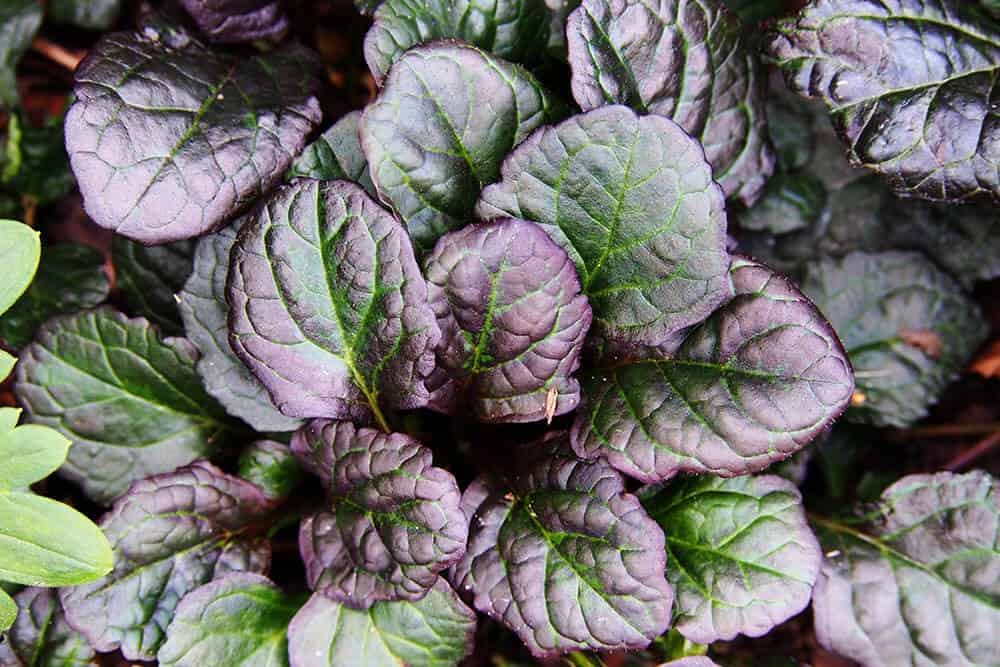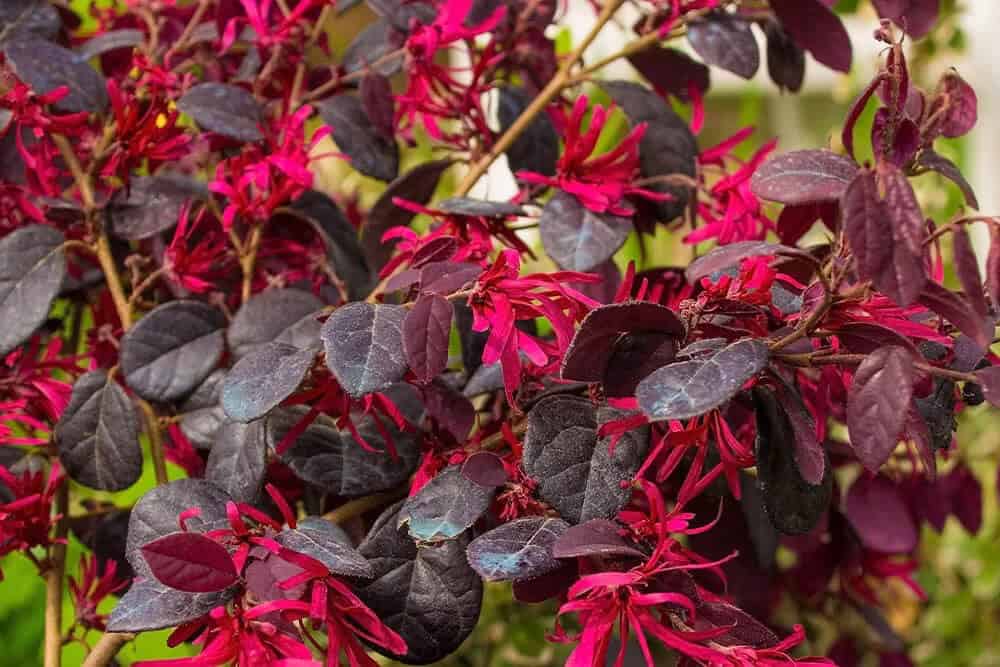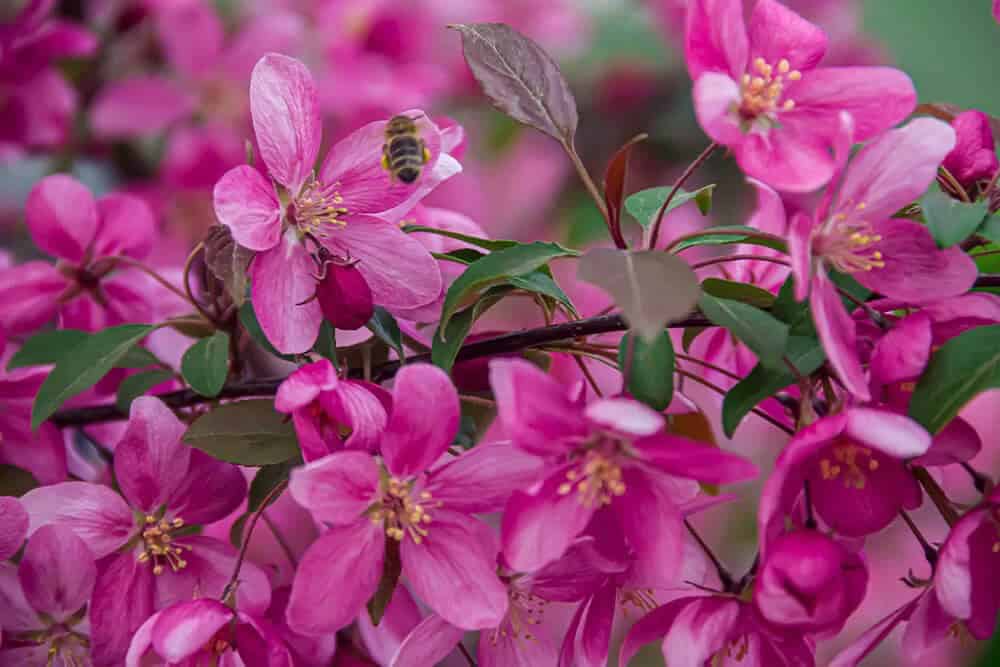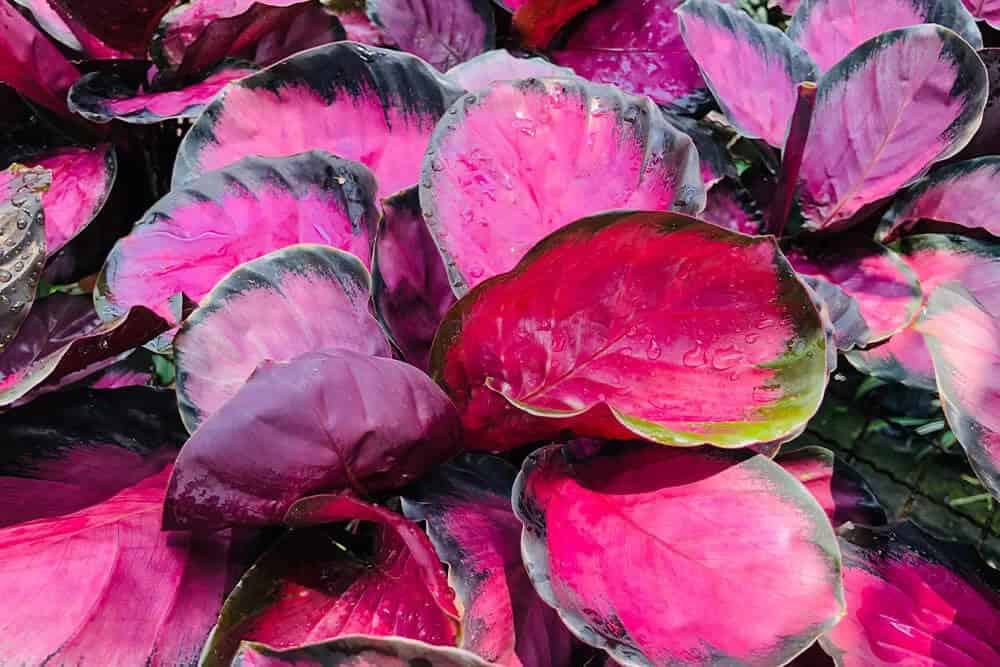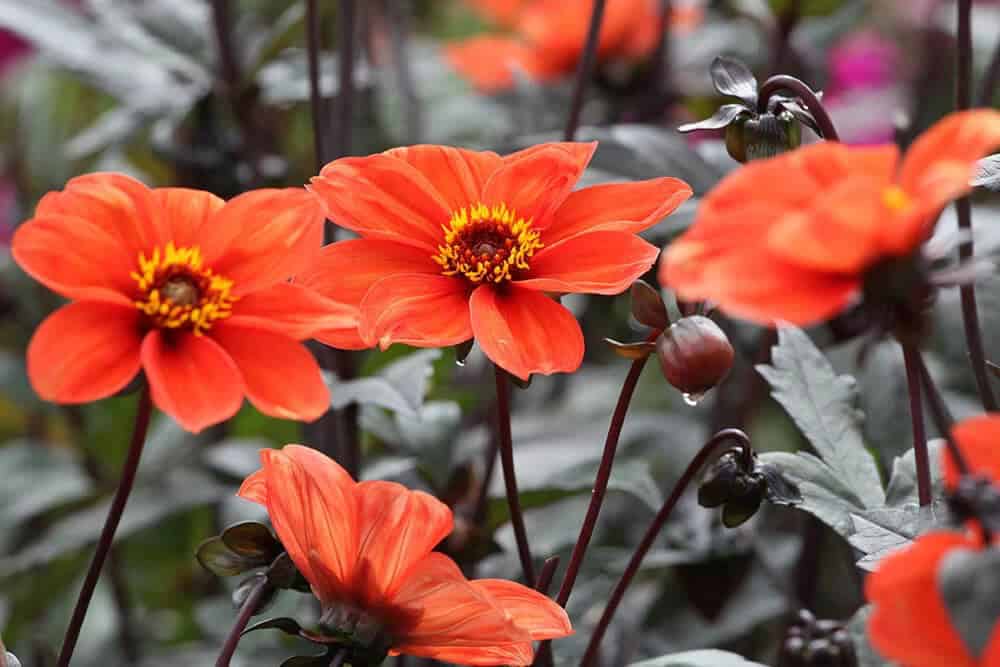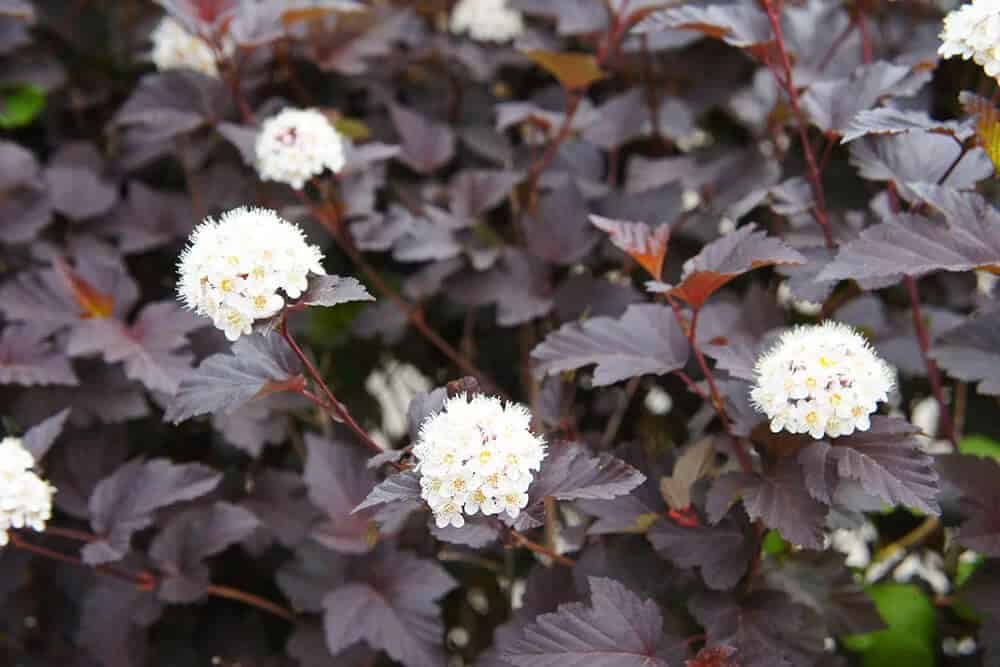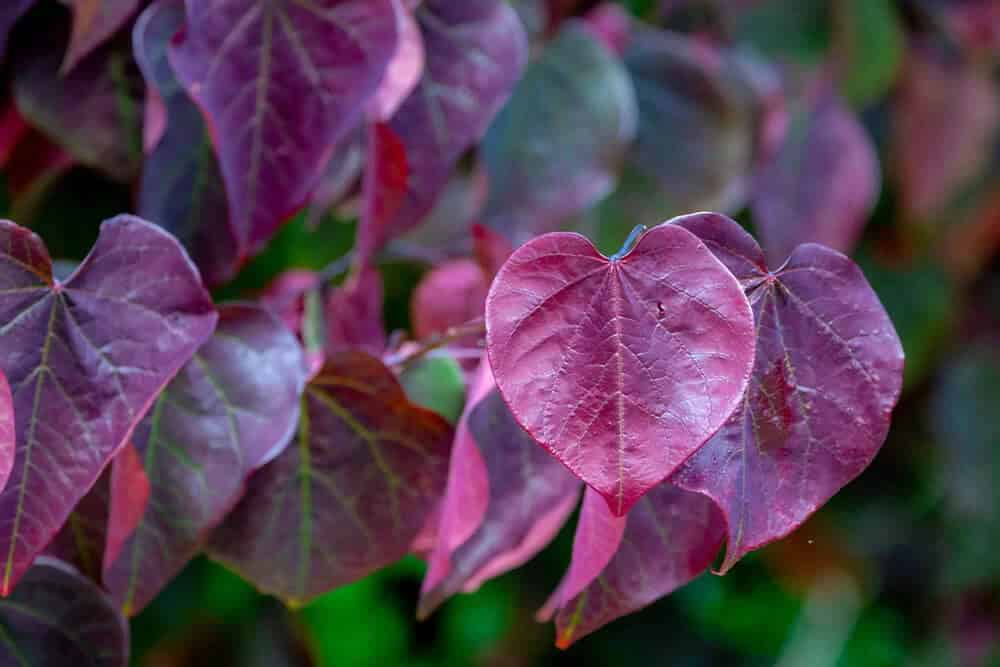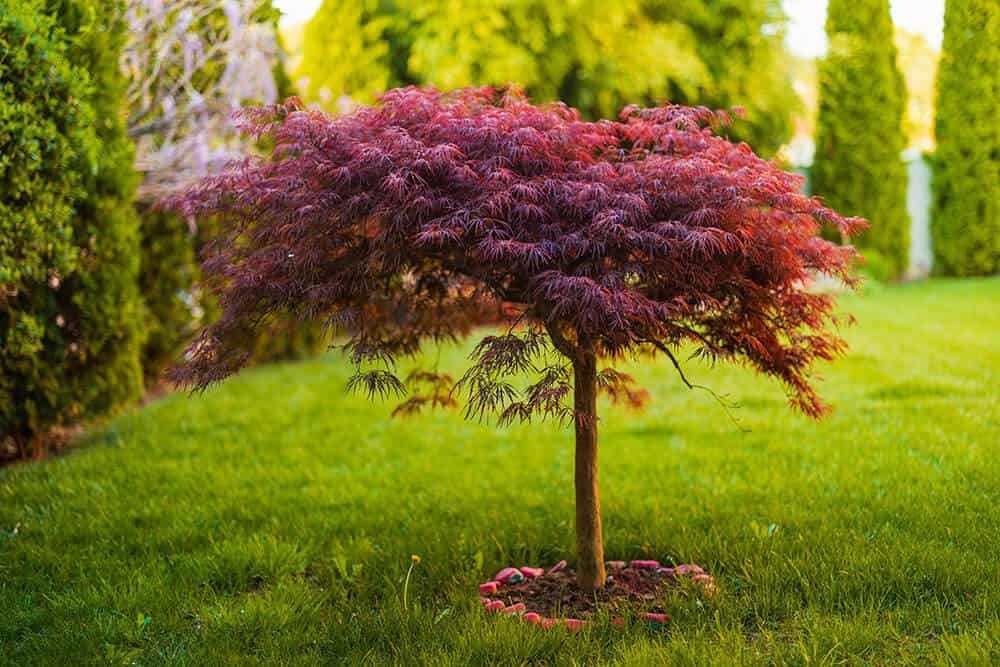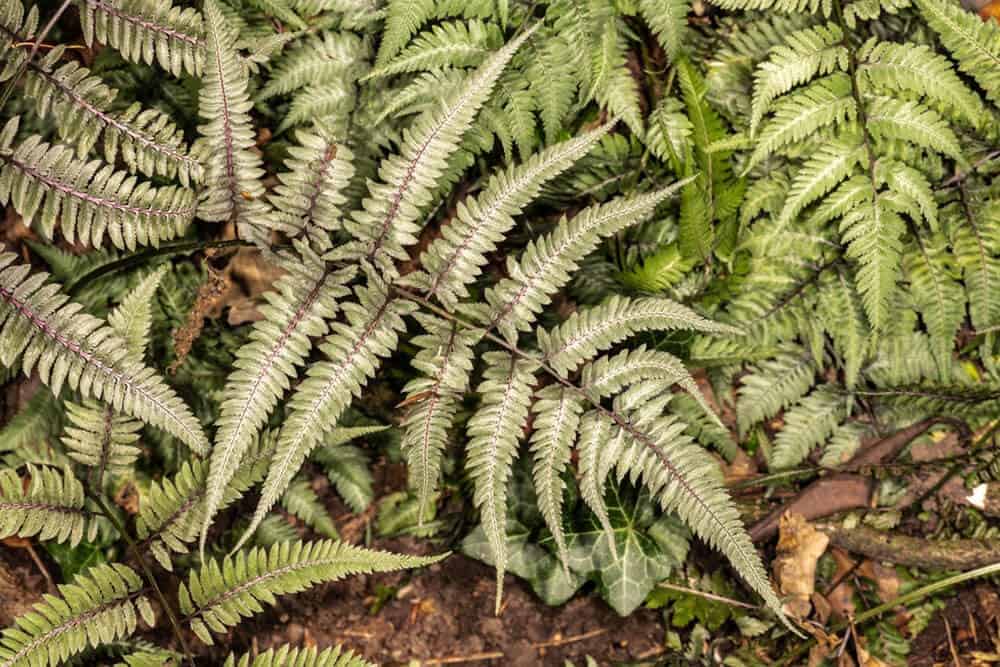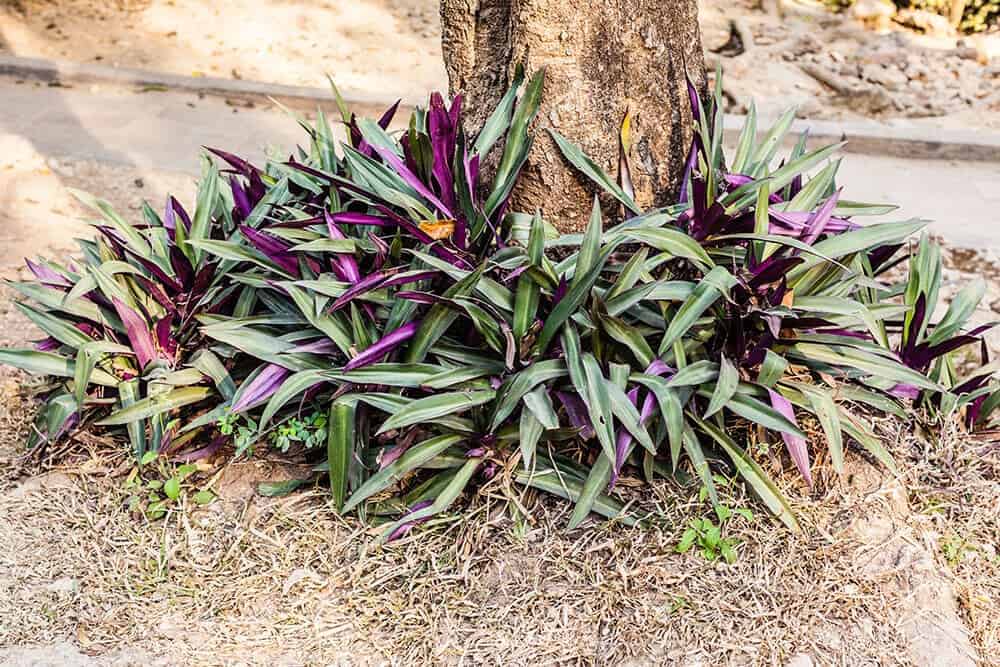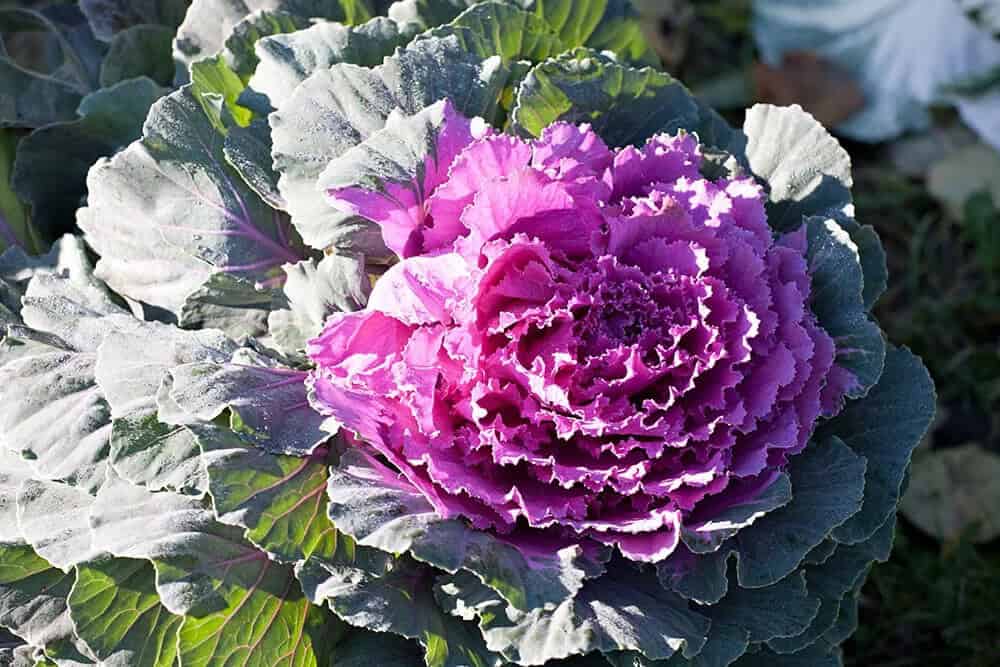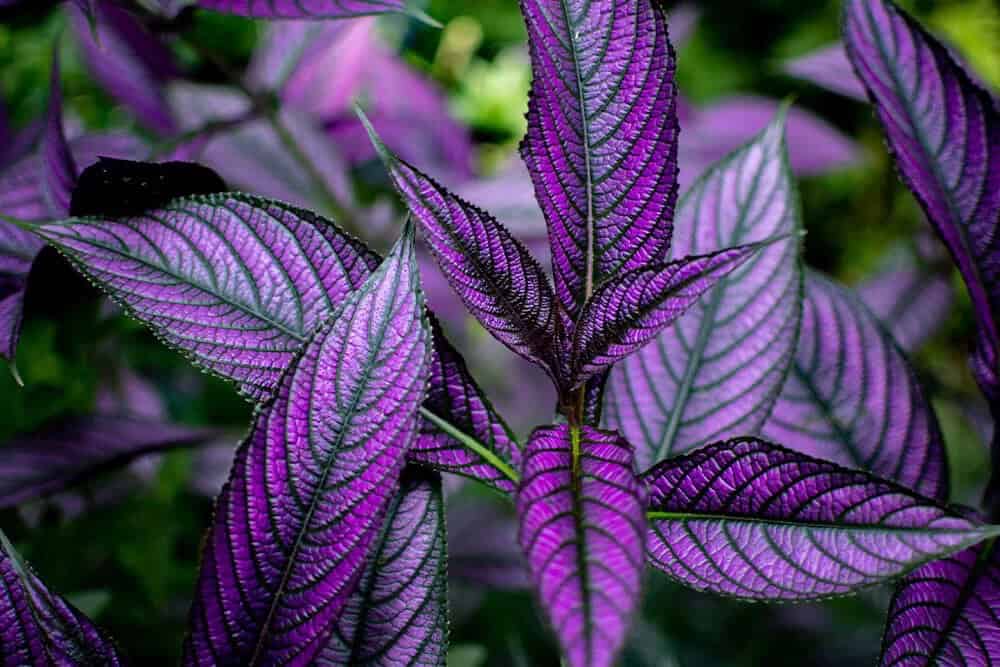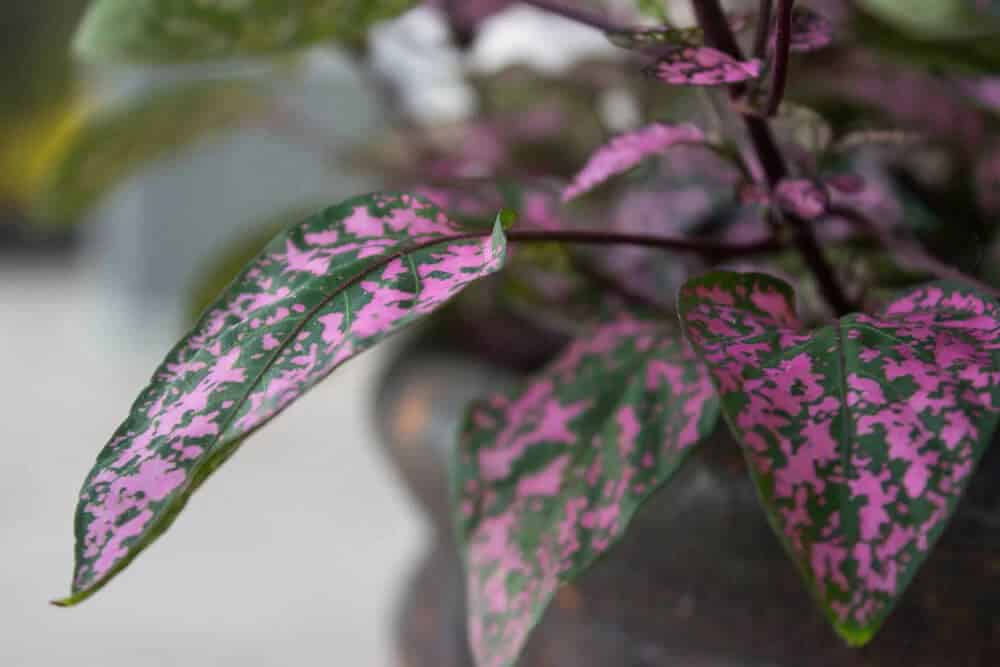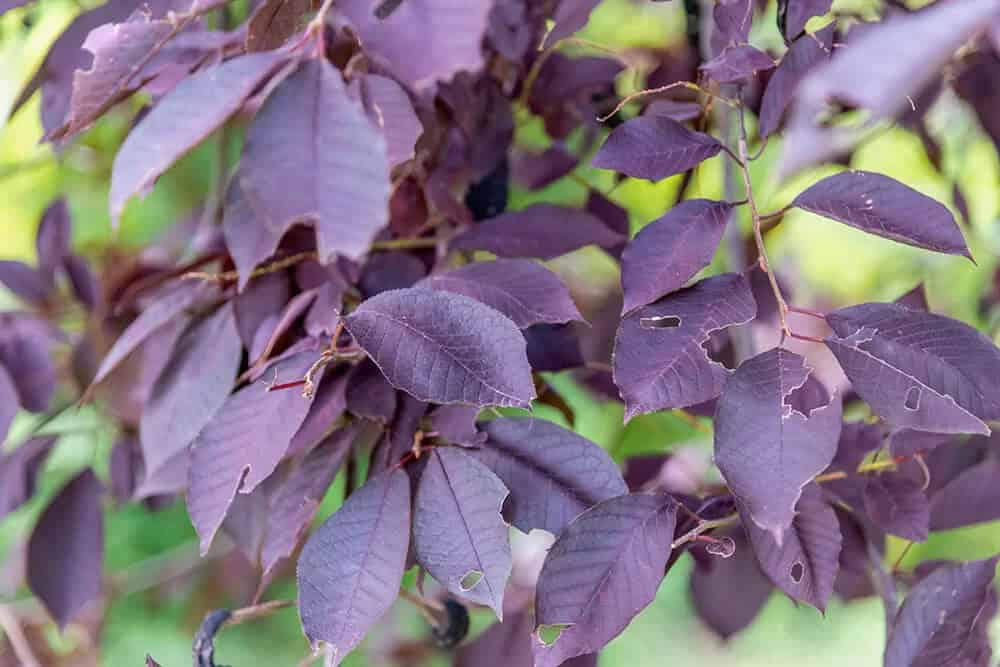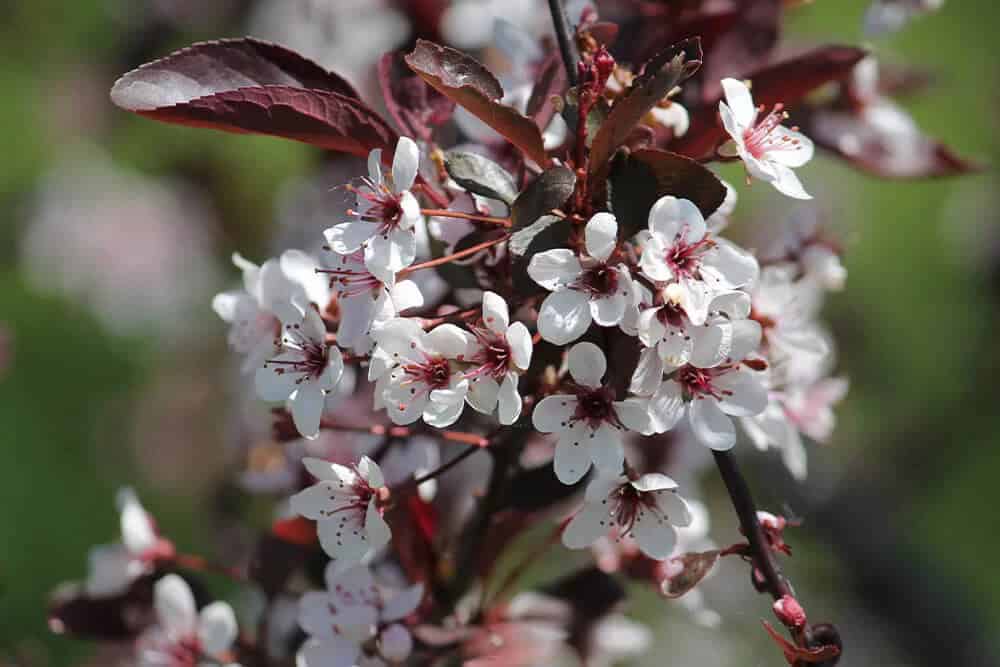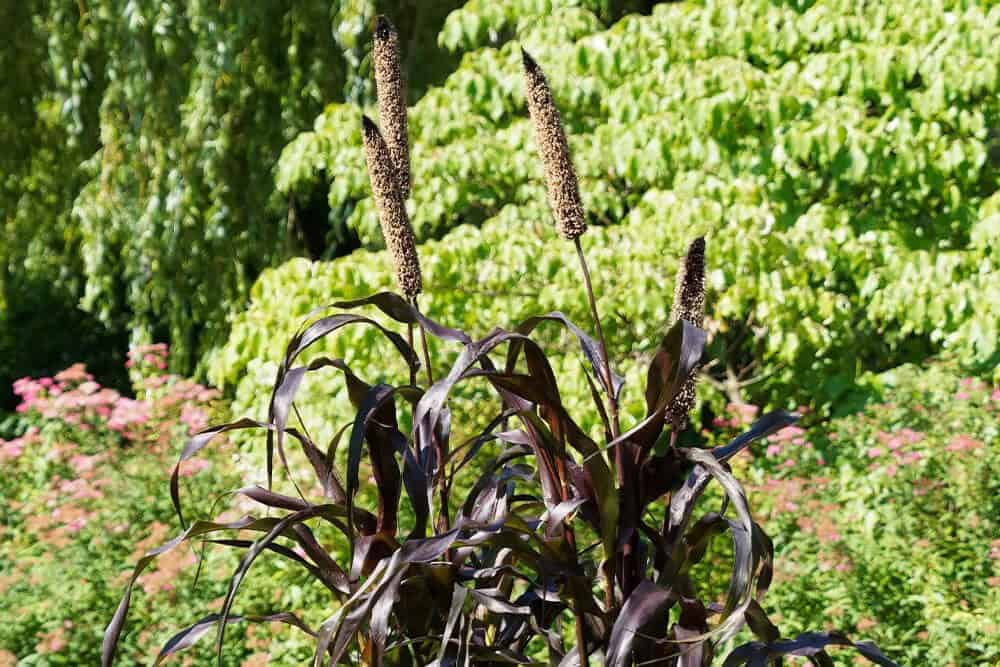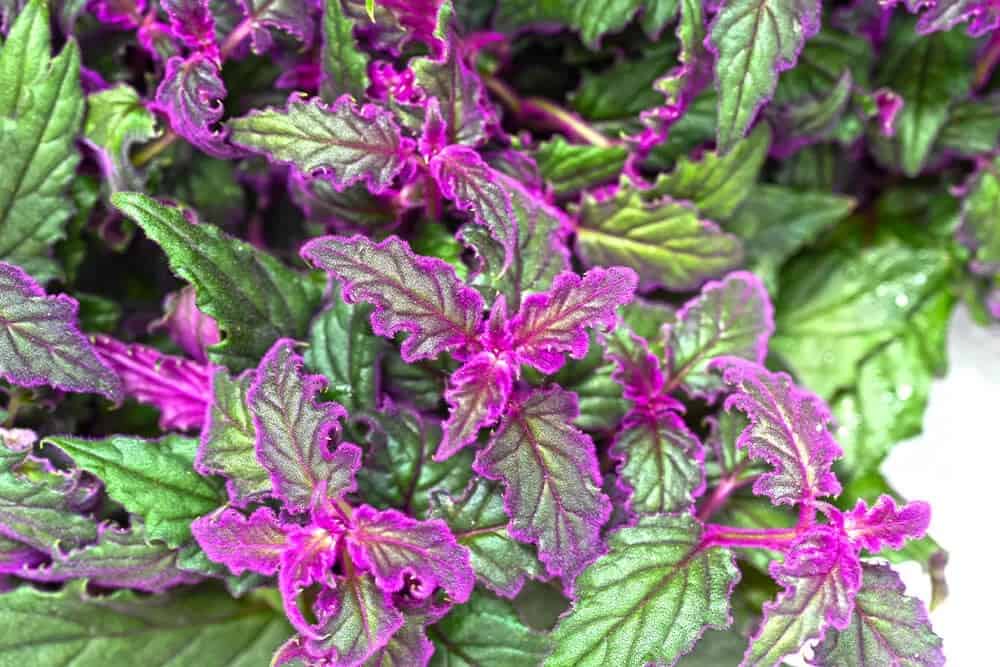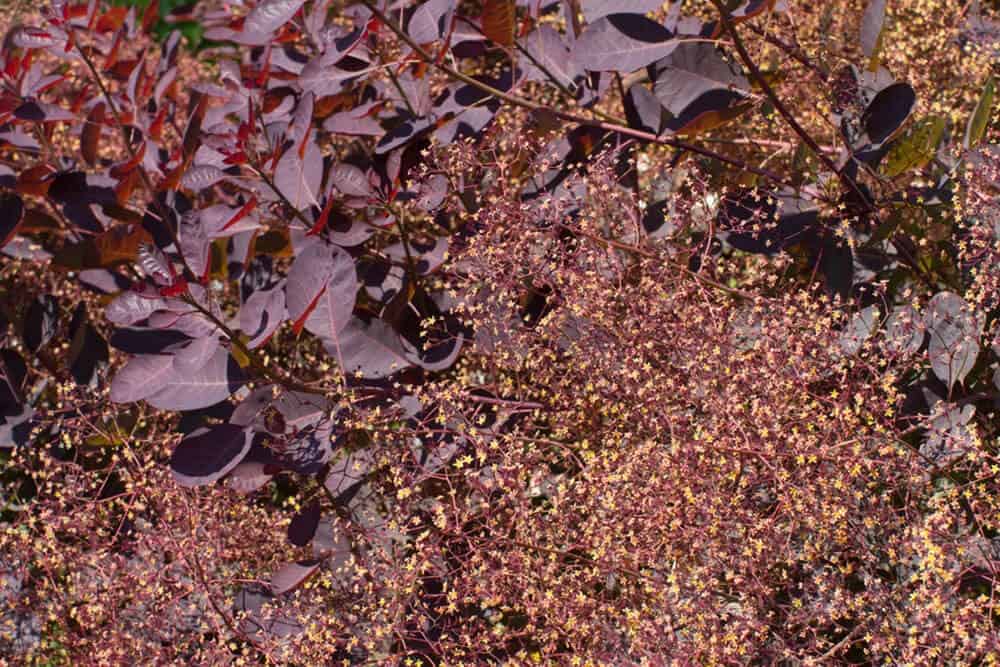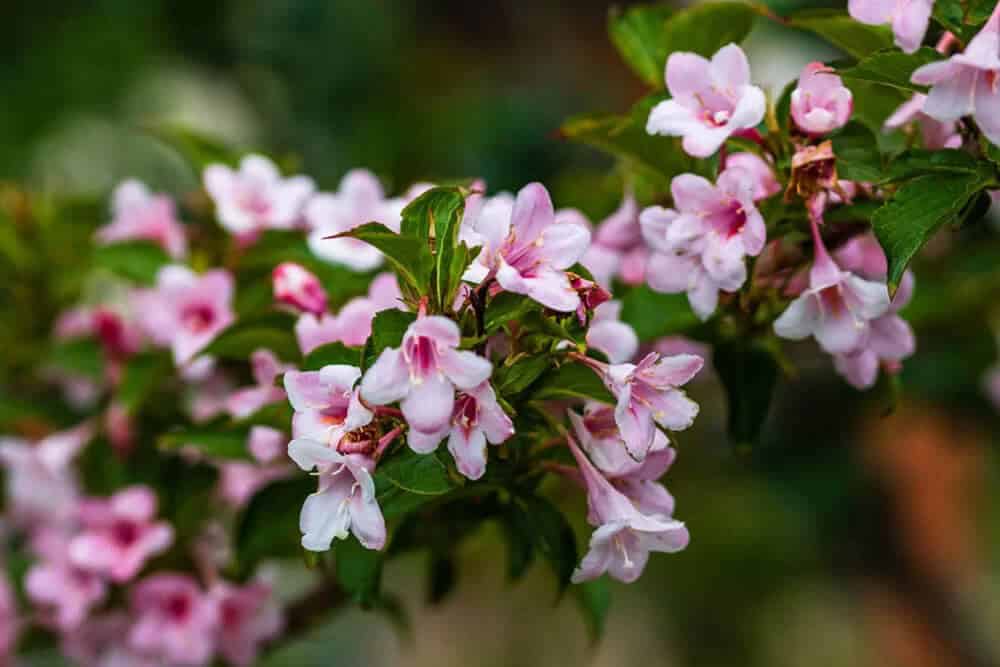While many gardeners adore the vibrant colors of purple flowers, a lesser-known gem lies hidden in the realm of foliage – purple-leaved plants. For those who cultivate their own green spaces and have a fondness for this regal hue, it’s time to discover the 25 unexpected yet stunning plants that don their beauty with purple-tinged leaves. As you read on, get ready to elevate your next planting project with these understated yet captivating additions.
Key Takeaways
The allure of plants with purple leaves lies not only in their distinctive appearance but also in the diversity of plant families they belong to. As you explore our list, you’ll notice each entry has its unique set of growing requirements and characteristics. Despite these differences, five key traits will emerge repeatedly: First, purple-leafed plants can take many forms, including perennials, shrubs, and trees that are woody or evergreen in nature.
Second, the intensity and hue of foliage color can vary significantly from one plant to another. Third, some plants with purple leaves boast spectacular purple blooms, adding an extra layer of visual appeal. Fourth, both evergreen and deciduous species can exhibit this striking leaf color. Finally, many plants with purple leaves are cultivated or hybrid varieties, reflecting the popularity of these showy specimens in gardens and collections.
25 Fantastic Types of Plants with Purple Leaves that Come in Many Forms
Azalea (Rhododendron ‘Conlee’ Autumn Amethyst)
The Rhododendron ‘Conlee’ AUTUMN AMETHYST azalea stands out for its remarkable dual appeal. Its unique foliage transforms from a greenish-purple hue in the summer to a deeper, richer purple during the winter months. Additionally, this variety boasts exceptional blooming characteristics, featuring blooms that emerge during the typical spring season and potentially reappear later in the year.
This combination of vibrant flowers and striking foliage renders the Rhododendron ‘Conlee’ AUTUMN AMETHYST an evergreen shrub that’s sure to captivate any lover of purple.
Bugleweed (Ajuga reptans ‘Catlin’s Giant’)
Imagine having a stunning purple carpet in your outdoor living space. While this may seem like a fantasy, it’s actually more achievable than you might think. The key lies in selecting the right plants to bring this vision to life. One such option is bugleweed, specifically the ‘Caitlin’s Giant’ variety. This evergreen perennial ground cover grows just a few inches tall and thrives in hardiness zones 3 through 10, making it suitable for most regions across the United States.
With its ability to survive harsh conditions, this plant offers a practical solution for creating a beautiful outdoor space.
Chinese Fringe Flower (Loropetalum chinense var rubrum ‘Zhuzhuo Fuchsia’)
What sets the Chinese fringe flower apart from other plants with purple leaves is not just its stunning foliage, but also the dramatic contrast it presents during bloom time. The plant’s oval-shaped leaves boast a deep, rich purple hue that provides a beautiful backdrop for the vibrant, textured flowers. These blooms are characterized by their frilly, magenta-colored petals that burst forth in a showy display, drawing the eye and captivating the senses.
Coleus (Coleus)
Coleus plants have gained popularity among ornamental foliage enthusiasts for their stunning and vibrant displays of colored foliage. One of the standout features of coleus is its unique leaf patterns, which often combine multiple colors in striking combinations. As you explore the various color options available, you’re likely to come across varieties that feature purple as a prominent or accent color.
While coleus can be grown outdoors, it does require warm weather year-round, making indoor cultivation necessary for those who want to enjoy its beauty.
Coral Bells (Heuchera)
Coral bells is an ideal perennial for small spaces due to its compact nature, typically growing no taller than a foot. Its adaptability to shady conditions also makes it a great option for areas with limited sunlight. One of the most attractive features of coral bells is its bell-shaped blooms, which add visual interest to any garden or container.
Additionally, this plant comes in a range of varieties featuring either green or dark purple leaves, making it a versatile choice that can complement various decorating styles. Ultimately, coral bells’ charm lies in its ability to bring beauty and convenience to even the smallest spaces.
Crabapple (Malus)
Crabapples are renowned for their stunning displays in early spring, with vibrant flowers in shades of white, pink, or purple depending on the variety. But what’s lesser known is that some crabapple varieties boast a unique twist – instead of traditional green leaves, they feature striking purple foliage. These varieties offer a bold splash of color to the landscape during both spring and summer, making them a compelling choice for gardeners seeking added visual interest.
Crimson Pink Calathea (Calathea roseopicta ‘Rosy’)
The striking aspect of the crimson pink calathea (Calathea roseopicta ‘Rosy’) is not only its bold purple hue on the leaves, but also the intricate pattern that makes each leaf truly unique. The majority of the leaf surface boasts a vibrant pink shade reminiscent of hot pink, while a thick border of dark green runs along the edge. This striking combination of colors creates a stunning contrast that has earned the crimson-pink calathea its coveted place in many indoor gardens.
Dahlia (Dahlia ‘Bishop of Oxford’)
Dahlias are renowned for their striking appearance, and some species boast purple leaves that add an air of elegance to any garden. Among these is Dahlia ‘Bishop of Oxford’, a variety that stands out for its dramatic combination of deep, almost black stems and leaves, which provide a striking backdrop for the vibrant orange blooms that burst forth amidst the foliage.
While the dark tones may give the appearance a hint of mystery, the overall effect is one of bold beauty, showcasing the unique charm of this captivating flower.
Diablo Ninebark (Physocarpus opulifolius ‘Monlo’)
The Diablo Ninebark’s moniker is aptly chosen, for its dark purple leaves can be unsettling at first encounter. Yet, like the preceding Dahlia, this shrub tempers its somber tone with white flower clusters that dot its foliage each year. As it matures under ideal conditions, the Diablo Ninebark can reach heights of 8 to 10 feet, making it a suitable hedge option.
Echeveria (Echeveria)
While the echeveria plant’s unique foliage with a soft purple undertone sets it apart, its popularity among indoor growers also stems from its succulent nature. The thick, fleshy leaves of this plant, characteristic of most succulents, have a peculiar arrangement that resembles the petals of a rose flower. A notable difference between echeveria and roses lies in the texture of their foliage – whereas rose petals are delicate and thin, those of the echeveria plant are sturdy and chunky.
Moreover, the color of its leaves can shift from light purple to pale green with subtle purplish nuances, adding an extra layer of visual interest.
Forest Pansy Eastern Redbud (Cercis Canadensis ‘Forest Pansy’)
For those seeking a small tree with ornamental appeal and a knack for supporting local wildlife, the Eastern redbud is an excellent choice. Native to their surroundings, these plants excel in fostering biodiversity. Additionally, they are early bloomers, boasting vibrant purple flowers that make their presence known in early spring.
The forest pansy Eastern redbud variety takes this aesthetic further by infusing its large heart-shaped leaves with a subtle purple hue for at least part of the year, adding an extra layer of visual interest to the landscape.
Japanese Maple (Acer Palmatum)
Japanese maples are a ubiquitous sight in residential landscaping, with many homeowners incorporating these ornamental trees into their outdoor spaces. One of the key factors behind their enduring popularity is the striking coloration of their leaves, which often display a vibrant reddish-purple hue during the majority of the growing season.
In addition to their eye-catching foliage, Japanese maples are also prized for their refined growth habits, which add a touch of elegance to any garden or yard, regardless of the time of year.
Japanese Painted Fern (Athyrium Niponicum)
While many people might perceive ferns as solely impressive due to their unique habit and texture, the color profile is often overlooked. But, the Japanese-painted fern is an exception – its vibrant hues can include stunning shades of purple, silver, and beyond. Moreover, this variety proves to be an excellent perennial ground cover choice for areas with limited natural light, making it an attractive option for those seeking a low-maintenance solution.
Moses in the Cradle (Tradescantia spathacea)
The Moses in the cradle plant is characterized by its striking foliage, with long, slightly pointed leaves showcasing a mesmerizing display of colors. Typically, these leaves exhibit a harmonious blend of hues, including purple, white, and green, which can be arranged in captivating patterns along the leaf’s length.
In some instances, this results in an ethereal pastel-like effect, while other times, individual leaves may boast a solid color, with adjacent leaves featuring contrasting shades, such as deep purple and vibrant green.
Ornamental Cabbage (Brassica oleracea)
While the term ‘cabbage’ may evoke images of bland, everyday vegetables, ornamental cabbages defy this expectation with their stunning, vibrant leaves. These plants exhibit a striking resemblance to regular cabbage, yet they offer a unique twist: the center can vary in color from creamy white or soft yellow to deep, rich purple hues.
The visual appeal is further enhanced by the ring of green foliage that surrounds the colorful core, making ornamental cabbages a visually striking addition to any garden.
Persian Shield Plant (Strobilanthes dyerianus)
While some plants on our list exhibit subtle hints of purple in their leaves, there are others that proudly display this rich color. A prime example is the Persian shield plant, which boasts pointed leaves with an elongated heart shape. The real showstopper, however, is the striking violet hue that dominates each leaf’s surface.
Adding depth to its appearance are the dark green veins and margins, creating a visually appealing contrast that makes it difficult to ignore this plant’s stunning purple coloration.
Polka Dot Plant (Hypoestes phyllostachya)
The Polka Dot Plant is another stunning option for indoor gardening, boasting leaves with a unique, irregular speckled pattern. Depending on the specific variety, its vibrant colors can range from a deep purple hue to other striking shades. One of the key factors in promoting healthy growth and optimal foliage development is providing bright indirect light in an indoor setting. By doing so, you’ll be able to appreciate the full beauty of this captivating plant.
Purple Elephant Ear (Colocasia esculenta ‘Black Magic’)
The instant you lay eyes on the purple elephant ear plant, its unique characteristics become self-evident. The large leaves of this plant are unmistakably reminiscent of an elephant’s ears, hence its common name. When selecting the ‘Black Magic’ variety of Colocasia esculenta, you can be certain that each leaf will boast a deep, bluish-purple hue. Occasionally, these leaves exhibit a glossy texture, lending an air of tropical elegance to your plant.
Purple Heart Plant (Tradescantia pallida)
The Purple Heart Plant is another striking addition to our list, boasting not only gorgeous leaves with a range of purple hues but also lovely flowers. While its leaf coloration can vary from light to dark purple, the blooms typically display a brighter, pinkish-purple tone. This compact plant makes an ideal container species, often spilling over the edges of its pot in a cascade of purple foliage.
To achieve optimal results, be sure to position your Purple Heart Plant in a spot that receives full sunlight each day.
Purple-Leaf Plum (Prunus cerasifera ‘Krauter Vesuvius’)
While purple-leaf plums may not be grown for their fruit, they’re a popular choice for their striking beauty. The deciduous trees are characterized by their dark purple leaves, which turn out to be the main attraction during spring and summer. As an added bonus, these trees also produce light pink flowers in the spring. When it comes to care, purple-leaf plums are relatively low-maintenance throughout their lifespan.
However, if you want to truly unlock the full vibrancy of your plant’s leaves, consider planting them in a spot that receives full sunlight – this will help bring out their natural brilliance.
Purple Sand Cherry (Prunus x cistena)
Rather than being grown for its fruit-bearing capabilities, the purple sand cherry is a ornamental species that offers a unique feature – its stunning purple foliage. Unlike other trees, this one reaches a relatively compact height of around ten feet, boasting a rounded and upright canopy that’s perfect for small gardens or spaces.
Its petite stature makes it an ideal choice for those who adore plants with striking purple hues but struggle to find suitable options that won’t overwhelm their limited growing areas.
Purple Majesty Pennisetum (Pennisetum glaucum’ Purple Majesty’)
As we approach the climax of our list, the plants truly start to flaunt their regal splendor. The majestic Pennisetum, with its stunning purple foliage, stands tall as a true showstopper. This ornamental perennial grass typically grows between three and four feet in height and is almost entirely enveloped by a rich, regal purple hue. But don’t let its grandeur fool you – this plant also boasts impressive durability.
In fact, once established, the purple majesty Pennisetum demonstrates admirable resilience to drought and requires minimal maintenance efforts, making it a low-fuss yet high-reward addition to any garden.
Purple Velvet Plant (Gynura aurantiaca)
The purple velvet plant, also known as the purple passion plant, boasts foliage that radiates a mesmerizing glow. Its leaves are characterized by a pointed shape with dramatic, irregular margins, and while their base color is typically dull green, tiny purple hairs give them a radiant sheen. When provided with bright indirect light and a moderate amount of water, this unique species can be the perfect addition to an indoor planting scheme, serving as a stunning purple accent.
Royal Purple Smoke Tree (Cotinus coggygria ‘Royal Purple’)
The royal purple smoke tree is a standout choice for gardeners who want to add a pop of purple to their outdoor space. One of its most striking features is its deciduous foliage, which has an almost perfect oval shape and a unique greenish-purple hue. But the real showstopper is the tree’s seed clusters, which are large and reminiscent of wispy smoke. These clusters also have a beautiful pinkish-purple color, making them a true masterpiece of nature.
The royal purple smoke tree’s ability to produce such an abundance of purple color makes it a unique find in the world of trees.
Weigela (Weigela florida ‘Wine & Roses’)
Weigela’s stunning blooms are a guaranteed way to elevate your garden’s visual appeal, regardless of the variety you choose to grow. But if you’re looking for a particularly striking feature, Weigela florida ‘Wine & Roses’ is the top pick – its deep purple leaves provide a unique and eye-catching contrast with its lighter flowers.
While this variety stands out for its distinctive foliage, weigelas in general are prized for their ease of care and maintenance, making them a popular choice among gardeners. Whether you opt for a purple-leafed Weigela or one with more traditional foliage, these plants are sure to bring beauty and simplicity to your outdoor space.
Frequently Asked Questions About Plants with Purple Leaves
What Plant Has Purple Leaves?
Among the vast array of plants boasting vibrant purple hues, some species display this striking coloration naturally, while others have been meticulously cultivated by botanists. The diversity of purple-leaved plants is remarkable, encompassing a wide range of species and genera across various plant types – from towering trees to compact shrubs, perennial blooms, and everything in between.
For garden enthusiasts seeking to incorporate rich shades of purple into their outdoor spaces, the possibilities are endless, with a suitable option available for any desired plant type.
What Plant Has Dark Purple Leaves and Small Pink Flowers?
The allure of plants with purple leaves is undeniable, but when paired with light-colored flowers, it’s truly breathtaking. The juxtaposition of deep purple hues against delicate pink blooms creates a visually striking contrast that can’t help but draw attention. Two examples of plants that masterfully combine these elements are the purple heart plant and the purple sand cherry, featuring rich, dark purple foliage alongside dainty pink flowers.
What Plant Has Green and Purplish Leaves?
While some plants with purple leaves may display a single hue, others can exhibit a range of colors on their foliage. One common secondary color is green, which often complements the rich tone of the purple. The Persian shield plant is a notable example of this phenomenon, featuring a unique blend of green and purplish hues.
Additionally, some species of azaleas will transition from predominantly green leaves in summer to a more pronounced purple hue during fall and winter, offering a striking visual contrast.
Do Purple Leaves Exist?
While it’s true that purple leaves on plants do exist, what’s perhaps more fascinating is the sheer variety of plant species that boast these stunning features as their primary draw. Many of these plants owe their rich purple hues to cultivation, which has allowed botanists to selectively breed naturally occurring species to showcase even more vibrant colors.
This drive for visual interest has led to the creation of numerous cultivars with purple leaves, further expanding our options when it comes to adding a pop of color to our gardens or indoor spaces.
Are Purple Leaves Rare?
While rare, there are several types of plants boasting stunning purple foliage. In comparison to the vast majority of nursery-grown plants, these rare gems make up a minuscule proportion. Moreover, since many purple-leaved varieties have been cultivated through human intervention, the number of naturally occurring species with this unique trait is even more scarce.
This scarcity only adds to the allure and mystique surrounding these extraordinary plants, piquing the interest of many plant enthusiasts. To shed light on the mysteries of these enigmatic flora, we’ve compiled answers to some of the most pressing questions about plants with purple leaves below.
25 Impressive Types of Plants with Purple Leaves that Add Immense Appeal
While green foliage is a staple in many gardens, incorporating a pop of purple can add a unique touch. The options are vast and varied, making it easy to find a purple-leaved plant that suits your taste. From the numerous varieties showcased on our list, you’re bound to discover at least one that catches your eye.

